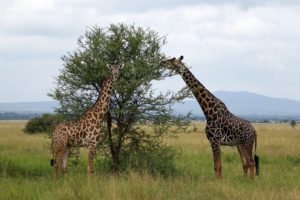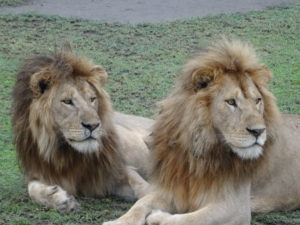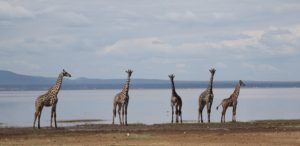Masai giraffes are the world’s tallest herbivores and beloved by people around the globe, but were recently classified as an endangered species by the International Union for Conservation of Nature (IUCN). New research published in Oecologia showed how food, predators, and people all influence giraffe social behavior. In particular, the international team of researchers from University of Zürich and Penn State University pinpointed the special requirements needed by mother giraffes to keep their babies safe, which can help land managers to protect the places most important for giraffes.

“Like all herbivores, giraffes need to find quality food to survive, but also need to avoid lions, or at least see them coming,” noted Monica Bond, PhD candidate at the Department of Evolutionary Biology and Environmental Studies, University of Zürich, member of the Population Ecology research group, and lead author of the paper. “Giraffes in our huge, unfenced study area can choose from among many different places to spend their time – places with different kinds of trees and bushes, and places deep inside protected parks or closer to farming towns or ranchlands where people live. There are lots of options in this landscape, including fewer lions outside the parks versus inside. So we wondered, how do these options influence giraffe grouping behavior? These data help us know what places are most important for these magnificent animals.” The study found that groups composed of adult giraffes were food-focused, not affected by predation risk. Adults formed the largest groups, up to 66 individuals, in the rainy season when food is plentiful, but smaller groups during the dry season when food is harder to find. In contrast, predation risk was a very important factor influencing congregations with calves.

“Giraffe calves are vulnerable to being killed by lions and other carnivores, while adults are typically large enough to escape predation,” stated senior author Barbara König, professor at the University of Zürich. “We were testing hypotheses about mother and calf behavior to see if their strategy was for calves to hide in thick bushes to avoid predators, be in the open to see predators coming, or be in large groups for many eyes and lower individual risk.” The researchers documented that in areas with the most lions, groups with calves were found more often in dense bushes than open grasslands, and those groups were smaller in size. This suggests giraffe mothers and calves have a strategy of hiding in dense bushes, rather than staying in open areas to better see lions, or gathering in large groups to dilute the predation risk. These results mean that dense bushlands are important habitat for giraffe calves and should be protected. Some cattle ranchers promote shrub removal to encourage grass for their livestock, but they share the rangelands with giraffes and other browsers that use shrubs.
The study also explored the influence of humans on giraffe grouping behaviors. “Outside the parks the human population has been rapidly expanding in recent years,” said Derek Lee, associate research professor of biology at Penn State University and co-author of the study. “Therefore, we felt it was important to understand how human presence affected grouping behavior, as natural giraffe habitat is ever-more dominated by people.” Interestingly, adult females with calves were more likely to be found closer to traditional pastoralist compounds called bomas, made by livestock-keeping, non-farming people. “We suspect this is because the pastoralists may disrupt predator behaviors to protect their livestock—and this benefits the giraffe calves,” noted Lee. Conversely, calf groups avoided areas close to farming peoples’ towns, suggesting a difference between traditional bomas versus more densely populated human settlements for giraffe mothers seeking food and safety for themselves and their calves.

“We were happy to find that traditional human settlements by ranchers appear to be compatible with the persistence of giraffe populations,” stated Bond. “But on the other hand, disturbances around towns likely represent a threat and should be limited in areas favored by giraffes.” The study was part of the world’s largest giraffe research project and used data from six years of systematic seasonal surveys across a 2,000 square kilometer area. The University of Zürich’s Population Ecology research group and its collaborators are at the forefront of giraffe conservation science. Learn more about giraffe research and conservation at http://www.wildnatureinstitute.org/giraffe.html
